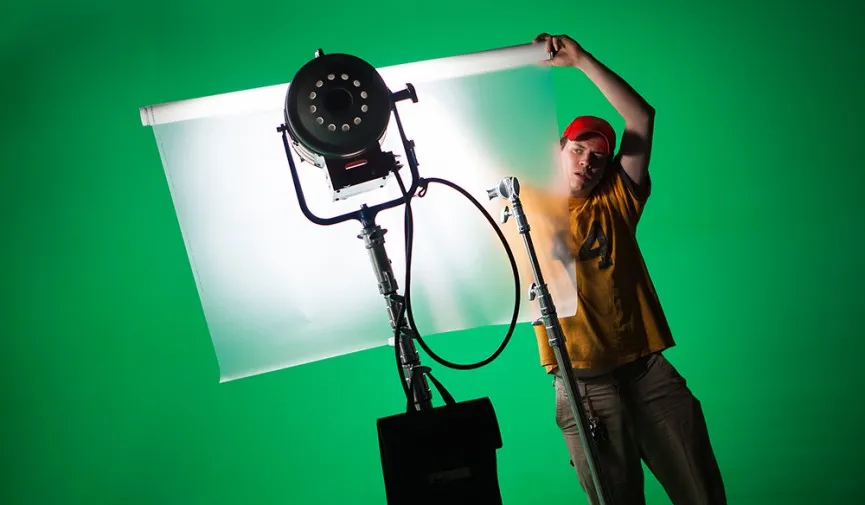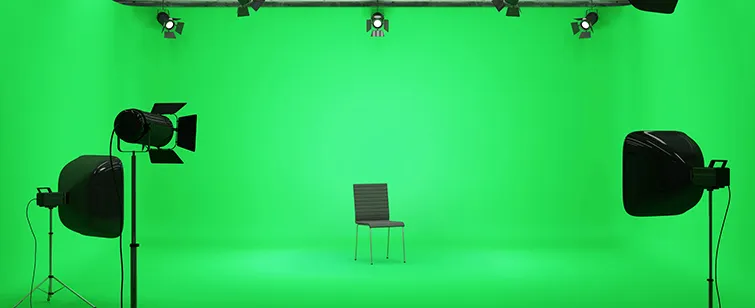Learning how to evenly light your green screen backdrop will give you better results when it comes time to edit your video.
Lighting a green screen is fairly simple from a technical perspective, yet many DPs who don’t have much experience with chroma key work are prone to making some unfortunate mistakes on set. Unlike traditional film lighting, which is all about finding contrast and mood by balancing light and shadows, lighting a green screen is all about evenness and consistency.
For the purpose of this post, I’ll describe a basic green screen lighting setup that involves only two background lights. While two lights might be all you need for many scenarios (such as an interview setup), keep in mind that the basic principles outlined here can be applied to wider and larger green screen setups too — you just may need to add more light.
This image is inconsistently lit. The editor will have a difficult time keying the darker edges of the frame.
The most crucial thing to remember when lighting your green screen: any area of the backdrop that appears in the frame must be lit perfectly even and exposed correctly. If your backdrop is lit properly on one side but underexposed on the other, your compositor or editor will have a very tough time pulling a clean key. The same applies to a backdrop that’s either over or underexposed. Any attempt to pull a key from a backdrop that isn’t actually reading as green on camera will inevitably be a failure.
Lighting Green Screen Backdrops
The key is the same for achieving soft light in any other shooting scenario — use big, soft light sources. If you point a hard light source (such as tungsten light with no diffusion) at your green screen, you’re going to run into trouble. The light will have a hot spot and there will be a gradient surrounding it, ultimately giving you an uneven light to work with.
The Basic Fundamentals Of Lighting a Green Screen: Soft Boxes
Conversely, if you were to point a tungsten light (let’s say a 2K source) at the green screen, but use a large 8 x 8 frame with a silk to diffuse the light, you’ll be in great shape. Personally, I prefer to use double diffusion when shooting on a green screen. My ideal setup typically involves a bright light source that’s first diffused by a standard 4 x 4 silk on a C-stand, and another 8 x 8 frame in front of that silk for an additional layer of diffusion. This ensures that the light is as even and soft as possible.
Placing Green Screen Lights
Assuming your needs are relatively simple, you can use a minimum of two lights to illuminate your backdrop. Using the setup described above, I recommend placing one light (with diffusion) on either side of the green screen, a few feet back on a 45 degree angle.
Right off the bat your results should be pretty close, and you can fine tune/adjust the angle of each light to make sure they’re not overlapping too much in the center. In other words, you don’t want to have a hotspot in the middle of your frame if both lights are spilling into each other. Be sure to adjust your lights and use flags when necessary, so your lighting is as even as possible.
The Basic Fundamentals Of Lighting a Green Screen: Green Screen Layout
It should also go without saying that you’ll want to use the exact same lights on either side of the green screen for the sake of consistency. If you’re using two different lights, you could run into exposure issues (or even worse, color temperature issues) which could once again cause headaches in post. With regards to the rest of your lighting setup, these will be creative decisions and are ultimately up to you.
If you want a more dramatic look on your talent, you can light them from the side. Alternatively, you might use two more flood lights on the talent’s face to create an even flat light. No matter what creative look you’re aiming for, the green screen will always need to be lit the exact same way.
On bigger productions, you may need to use overhead lighting, additional sources, or more diffusion, but the basic principles outlined here will apply no matter what.
For a quick video demonstration on a basic green screen lighting setup, check out this video from lynda.com:
Got any tips for working with a green screen? Share them in the comments below.




